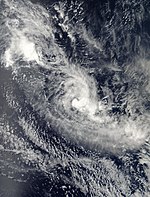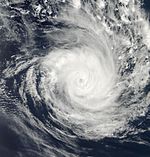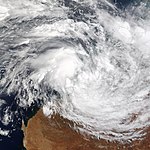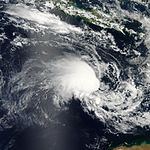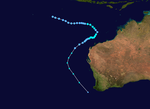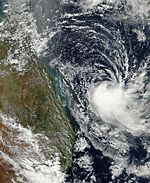2002–03 Australian region cyclone season
| 2002–03 Australian region cyclone season |
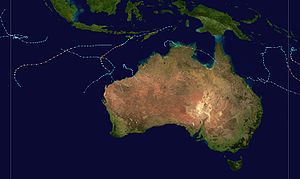
Season summary map
|
| Seasonal boundaries |
| First system formed |
27 December 2002 |
| Last system dissipated |
6 June 2003 |
| Strongest storm |
|
| Name |
Inigo |
| • Maximum winds |
240 km/h (150 mph)
(10-minute sustained) |
| • Lowest pressure |
900 hPa (mbar) |
| Seasonal statistics |
| Tropical lows |
11 |
| Tropical cyclones |
8 |
| Tropical cyclones |
3 |
| Total fatalities |
60 |
| Total damage |
$12 million (2003 USD) |
| Related articles |
|
|
Australian region tropical cyclone seasons
2000–01, 2001–02, 2002–03, 2003–04, 2004–05
|
| Tropical depression (SSHWS) |
|
|
| Duration |
27 December – 3 January |
| Peak intensity |
55 km/h (35 mph) (1-min) 1006 hPa (mbar) |
| Category 2 tropical cyclone (Australian scale) |
|
|
| Duration |
4 January – 25 January |
| Peak intensity |
95 km/h (60 mph) (10-min) 988 hPa (mbar) |
| Category 1 tropical cyclone (Australian scale) |
| Tropical depression (SSHWS) |
|
|
| Duration |
1 February – 5 February |
| Peak intensity |
65 km/h (40 mph) (10-min) 995 hPa (mbar) |
| Tropical low (Australian scale) |
| Tropical depression (SSHWS) |
|
|
| Duration |
3 February – 9 February (exited basin) |
| Peak intensity |
55 km/h (35 mph) (10-min) 1000 hPa (mbar) |
| Category 4 severe tropical cyclone (Australian scale) |
| Category 3 tropical cyclone (SSHWS) |
|
|
| Duration |
3 February – 13 February |
| Peak intensity |
175 km/h (110 mph) (10-min) 935 hPa (mbar) |
| Category 2 tropical cyclone (Australian scale) |
| Tropical storm (SSHWS) |
|
|
| Duration |
24 February – 1 March |
| Peak intensity |
95 km/h (60 mph) (10-min) 985 hPa (mbar) |
| Category 1 tropical cyclone (Australian scale) |
| Tropical storm (SSHWS) |
|
|
| Duration |
1 March – 11 March |
| Peak intensity |
85 km/h (50 mph) (10-min) 985 hPa (mbar) |
| Category 3 severe tropical cyclone (Australian scale) |
| Category 1 tropical cyclone (SSHWS) |
|
|
| Duration |
1 March – 12 March (Exited basin)
|
| Peak intensity |
150 km/h (90 mph) (10-min) 960 hPa (mbar) |
| Category 2 tropical cyclone (Australian scale) |
| Tropical storm (SSHWS) |
|
|
| Duration |
8 March – 13 March |
| Peak intensity |
100 km/h (65 mph) (10-min) 976 hPa (mbar) |
The 2002–03 Australian region cyclone season included Cyclone Inigo, which tied Cyclone Gwenda in 1999 as the most intense tropical cyclone on record in the Australian basin. It began on 1 November 2002 and ended on 30 April 2003. The regional tropical cyclone operational plan also defines a tropical cyclone year separately from a tropical cyclone season, which runs from 1 July 2002 to 30 June 2003. These dates conventionally delimit the period of each year when most tropical cyclones form in the Australian region, which is defined as in the southern hemisphere between 90°E and 180°E. The season's ten tropical depressions existed within these dates, with the first, designated as Tropical Cyclone 07S, entering the basin on 27 December 2002. The last system, Cyclone Epi, dissipated on 6 June 2003. Tropical cyclones in this area were monitored by four Tropical Cyclone Warning Centres (TCWCs): the Australian Bureau of Meteorology (BOM) in Perth, Darwin, and Brisbane and one in Port Moresby, Papua New Guinea.
Tropical cyclogenesis in the season began when a tropical low developed in the Arafura Sea on 5 January and last until 24 January, after meandering over northern and Western Australia. On 1 February, weakening Cyclone Beni entered the Australian region and brought severe flooding to Queensland, before dissipating on 5 February. Severe Tropical Cyclone Fiona formed north of Western Australia on 3 February and later peaked as a Category 4 severe tropical cyclone on the Australian tropical cyclone intensity scale. Cyclone Graham developed offshore Western Australia on 24 February and made landfall in a rural area of that state on 28 February, producing flooding in the area. Tropical Cyclone Harriet existed offshore of Western Australia from 1 March to 11 March.
...
Wikipedia








